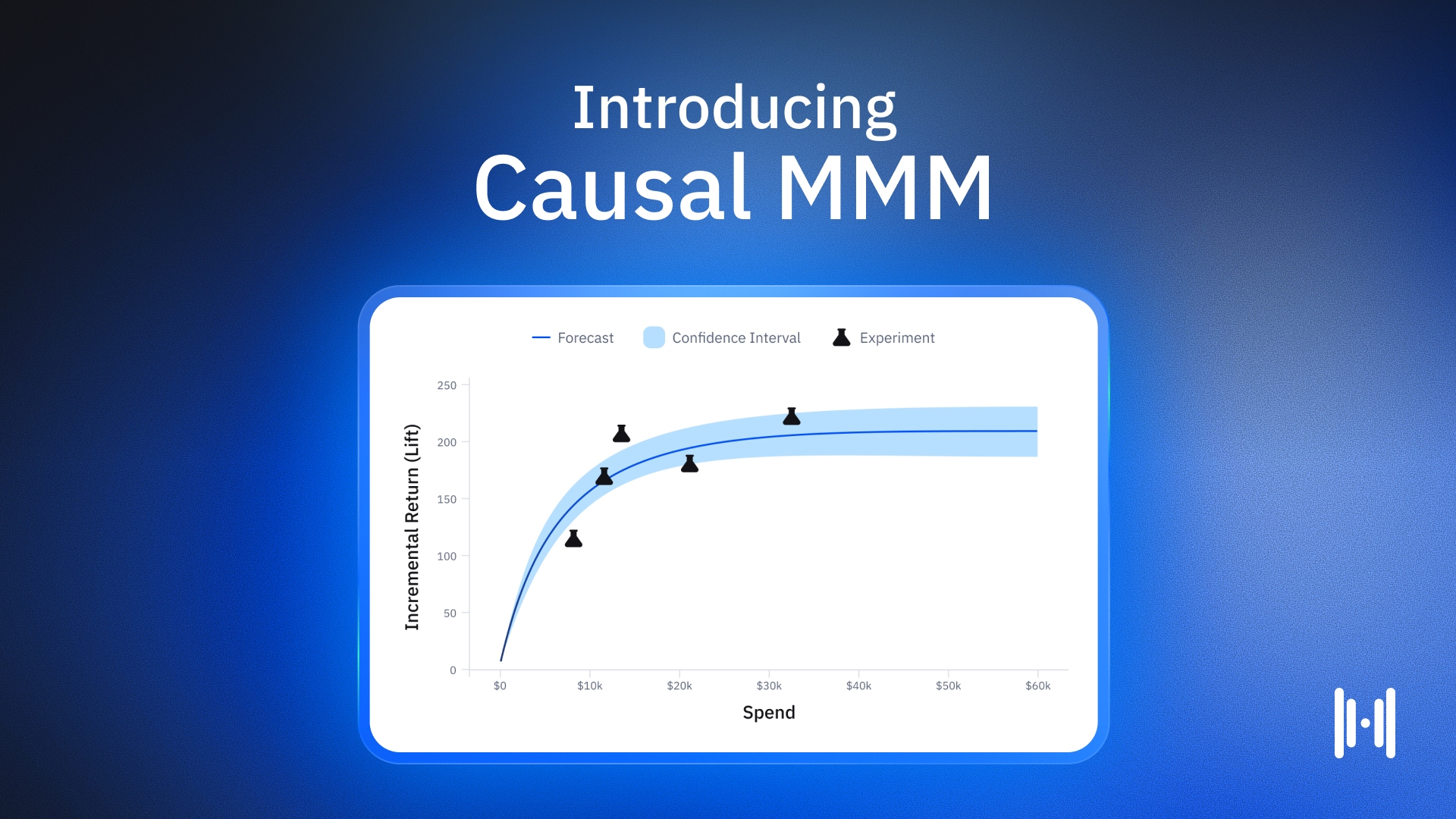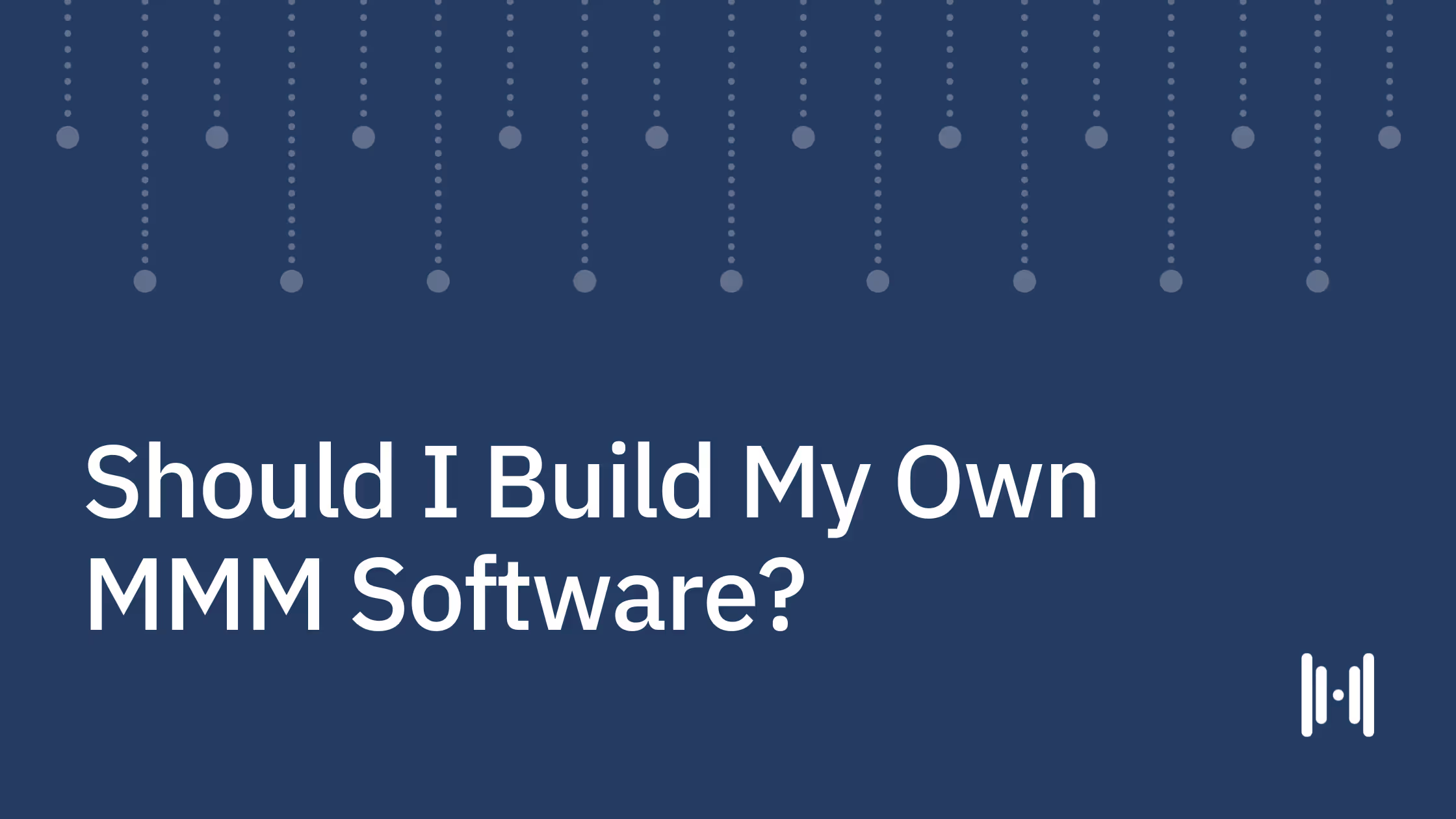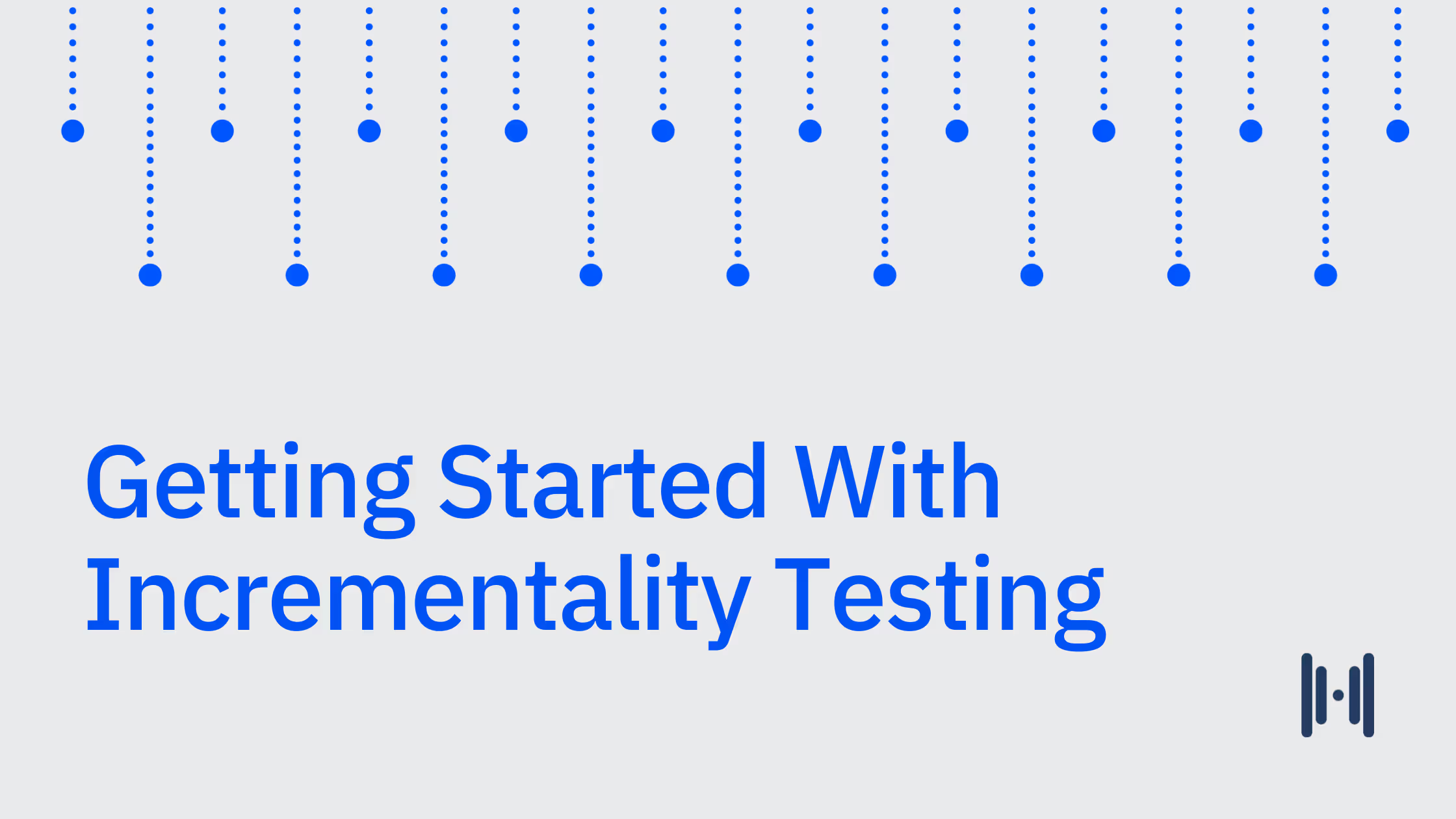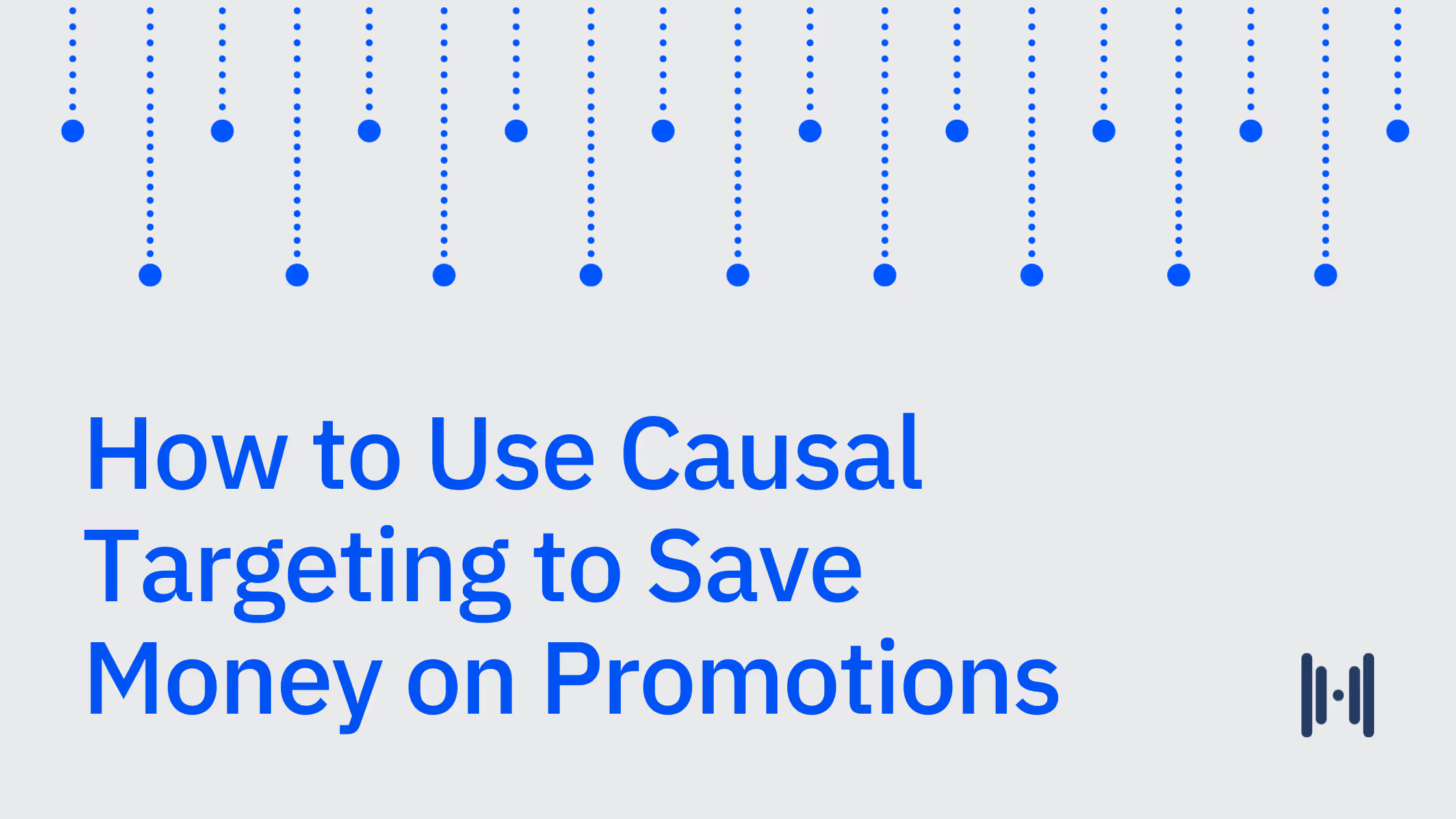
So you’ve decided to add a marketing mix model (MMM) to your measurement stack. If so, you’re certainly not alone — plenty of marketing teams have turned to MMM in recent years to get a comprehensive view of their marketing performance across channels.
At Haus, we have a strong viewpoint around MMM, particularly when it comes to traditional MMM versus causality-driven MMM. We’ve seen far too many teams get bogged down by the lack of transparency and trust that comes with a traditional MMM. That’s why we’re building Causal MMM (coming later in 2025), which treats experiments as ground truth. This leads to more consistent, precise, and actionable spend recommendations.
The absolute necessity of causality at the core of your MMM is why we’re skeptical about teams that want to build their own in-house MMM. Too often, teams lack the resources or expertise needed to build rigorous causal inference models. Instead, they wing it with an MMM that is “test-calibrated” or “reinforced with experiments,” which is a far cry from a model that puts causality at the core.
At the same time...we get it. The prospect of avoiding vendor lock-in is always tempting. And the chance to customize an MMM specific to your team is always appealing. Plus, the emergence of open-source MMM tools like Google’s Meridian and Meta’s Robyn have made MMMs appear more accessible, enabling teams to cut down on development time.
But this line of thinking underrates two realities:
- Relying on an untrustworthy traditional, non-causal MMM is a liability to your bottom line.
- Building a truly causal MMM requires significant resources.
As scientific folks, we naturally want to back up these claims. So in the spirit of rigorous, evidence-backed analysis, this guide will lay out the advantages and disadvantages of building your own MMM and explain why you need causality at the core of whichever MMM software you end up choosing.
The core question: Build or buy?
Before we go any further, let’s review that third M in MMM: model. A model is a mathematical representation of the relationship between variables (in this case, your different marketing channels). This model is then used to inform recommendations. The goal is to design a model powerful enough to generate consistently accurate recommendations. Still — because we aren’t able to exactly predict the future — these recommendations are merely directional.
Our viewpoint is that experiments are the gold standard, so the more a model is grounded in experiments, the more accurate its recommendations are. That’s why traditional MMMs, which aren’t grounded in experiments and rely on correlation, can lead to inaccurate results.
Building an MMM grounded in causal truth is a highly sophisticated process. So when teams say they’re building an in-house MMM, they’re often talking about building a traditional MMM. This opens you up to potentially inaccurate, unreliable recommendations. And building this traditional MMM in-house still won’t be easy. As the table below shows, you might feel more in control with an in-house MMM, but you’ll make major trade-offs when it comes to upfront costs, time-to-value, ongoing support, and maintenance.
If your company doesn’t have in-house expertise in causal inference, econometrics, and marketing analytics, the risks of building your own MMM far outweigh the benefits. If you decide to hire expertise to fill in these gaps, expect months of competitive recruiting — and prepare to earmark at least seven figures of payroll toward causal inference talent.
Open-source MMM: A middle ground?
For those considering a DIY approach, open-source MMM solutions offer a potential shortcut. In recent years, teams have turned to solutions like Robyn from Meta and Meridian from Google to get started with MMMs. But despite some benefits, there are also some steep trade-offs:
Pros:
- Time savings: Open-source MMMs save time that would otherwise be spent designing and building a model.
- Transparency: The codebase behind open-source MMMs is typically accessible on GitHub and usually includes thorough documentation and demos. Plus, data scientists from around the world can contribute to the codebase, improving the model over time.
Cons:
- Experiments aren’t ground truth: While open-source models like Robyn enable you to calibrate MMM results with experiments, they are not built on a foundation of experimental data — a subtle but far-reaching difference.
- Unstable results: Some users complain of results changing wildly once you refresh with new data — a common issue for models built on correlation data.
- No ongoing support: One of the benefits of working with a partner like Haus is the team of growth experts who help you act on model recommendations. Not only does a support staff help you run tests, but they also help you use them to unlock growth opportunities.
- Potential for bias: Given that these models are built by major ad players like Google and Meta, there is always the possibility they may overstate the performance of marketing tactics popular within their own platforms. Third-party measurement partners have an advantage in this regard.
So the trade-off is relatively clear: While these tools reduce initial development time, they still require strong engineering and data science resources to configure, customize, and maintain. Plus, experiments are tacked on after the fact, used as suggestions. Compare that to a causality-driven MMM where causal relationships are baked into the model’s architecture from the very beginning. Naturally, those recommendations will be more reliable.
How traditional MMM falls short
If you do decide to build your own MMM, we strongly advise against building a traditional MMM. Here are some of the common pitfalls of traditional MMM:
- Built on outdated data: Traditional models draw from 2-3 years of historical data to make their recommendations — but we all know marketing strategy and performance can change on a seasonal, monthly, and even weekly basis.
- Garbage in, garbage out: If the data going into a model is flawed, the insights returned from an MMM will also be flawed. And if you’re using a Bayesian MMM that uses priors, the model could become overfitted to (incorrect) prior assumptions.
- Oversimplified results: Traditional MMMs express channel performance using a single coefficient. In an ideal model, you’ll have coefficients tied to the many variables related to channel performance, such as changes in creative strategy or the launch of a new product. One result for multiple variables can lead to...
- Multicollinearity: Multiple variables may be affecting that single coefficient. For instance, scale, timing, and variability can all affect how an ad performs. How can you be confident in your results if you aren’t sure which input is driving which output?
- Lack of transparency: Multicollinearity becomes more of an issue when a vendor doesn’t report statistical significance metrics (e.g. confidence intervals, predictive power). And most vendors won’t unless customers ask for it.
- Hard to action on: When a channel’s performance is expressed as a single coefficient, it’s not broken down enough to be useful for planning and strategy purposes.
Aware of these shortcomings, some vendors have launched “test-calibrated MMMs.” But these are just traditional MMMs masquerading as causal MMMs, using experiment results as suggestions rather than ground truth. Be wary of these sorts of models, as well as vendors who downplay rigor or say experimentation is a commodity.
The case for Causal MMM
So if you’re going to build your own MMM, you’ll want to ensure it’s a Causal MMM. No, not “casual.” Causal. (There’s nothing casual about building a Causal MMM.)
A Causal MMM uses real-world incrementality experiments to isolate the true impact of each channel. These aren’t any old experiments; they are advanced geo-holdouts that use synthetic controls to deliver precise, actionable results.
Developing the infrastructure for this level of velocity and precision isn’t easy — it requires a team of causal inference experts. And this team can’t just be thrown together ad hoc. You need sophisticated internal systems and clearly defined roles that ensure iterative testing is aligned and efficient. Naturally, building this sort of well-oiled machine in-house is costly and time-intensive.
That’s why more brands put their trust in Haus to deliver precise, high-velocity experiments. With Causal MMM on the way, these same brands will soon be able to apply this “gold standard of causal inference” to marketing mix modeling — instilling a new level of transparency into MMMs.
The challenges of building an in-house causal MMM
In reality, an MMM is an advanced system that requires copious data, advanced regression models working “under the hood,” as well as regular maintenance and validation in order to ensure up-to-date, accurate recommendations. Here are some prerequisites for building an effective in-house MMM:
- Data integration: An MMM ideally should ingest years of data related to ad spend, conversions, offline sales, and external factors (seasonality, macroeconomic trends) into a unified pipeline. This data must be onboarded efficiently in order to speed up time-to-value.
- Expertise & staffing: You’ll need a team of causal inference experts, data scientists, engineers, economists, and marketing analysts if you want to build and maintain a best-in-class causal MMM. Even standing up a simpler open-source model will still require expertise in data science and marketing analytics.
- High-velocity experiments: If your MMM treats high-velocity experiments as ground truth, you’ll get a steady supply of trustworthy, actionable insights. This is far more time-intensive and advanced than merely validating model conclusions through holdout tests or “incrementality-based calibration.”
- Automation & maintenance: Another source of velocity? Automated software that helps you more quickly onboard data and update recommendations based on changes to your business. Once again, this requires a dedicated team to be done effectively.
This isn’t a one-time effort. Each of these areas requires dedicated teams of data scientists, analysts, and engineers. The upfront investment can take months or even years before yielding reliable insights. And — at the risk of repeating ourselves — those results might not be reliable if they aren’t based in causality.
The advantages of using a trusted MMM partner
If you’re up in the air about paying for an MMM vendor versus building your own, consider the following advantages of paid MMM software:
- Faster implementation: No 12-month development cycle here. Working with a partner like Haus will get you up and running quickly so that your model is available when you need it (...and not a year after you need it).
- Pre-built, validated models: When you work with a vendor, you won’t have to design the model, build it, and then assess its stability. These will be done for you, and the vendor’s track record of customer satisfaction will give you social proof of the model’s stability.
- Dedicated support: Getting insights from your MMM is only half the battle. Next, you’ll want to act on the most enlightening results and assess next-phase refinements. This is all much easier with a measurement partner’s in-house team of PhD data scientists, growth experts, and marketing analysts.
Potential Drawbacks
You will need to make two trade-offs when you purchase an MMM from a vendor:
- Ongoing cost: While building your own MMM will come with massive upfront costs, buying one will come with subscription fees. While a subscription model aligns more closely with most companies’ financial timelines, all businesses are different.
- Less customization: You’re working with the vendor’s model ultimately. While sophisticated vendors will tune the model to your business needs (especially if you’re a large enterprise business), it might not be as customizable as a home-grown model.
The bottom line: To buy or not to buy?
Yes, we speak (very) often about the benefits of causality when it comes to decision-making. But that’s only because we understand the heavy cost of imprecise, correlational measurement solutions. If you’re spending tens of millions on ads each year, you can’t risk your budget on an MMM that lacks accuracy and transparency. You could end up lighting ad dollars on fire.
For that reason, we’re pretty firm here: We think you should buy your MMM from a vendor that specializes in experiment-driven measurement. We strongly advise against pouring resources into a model that uses data from two or three years ago — especially in a volatile global economic landscape.
Are there exceptions? Maybe. You might be in a highly specialized industry that requires an MMM fully customized to your unique business. We realize all businesses are unique and at different points on their measurement journey. However, we believe that in the vast majority of cases, an in-house MMM isn’t worth the costs and potential inaccuracies.
Implementing Causal MMM – the Haus way
We hope this guide has given you a better sense of the pros and cons of building your own MMM. If you’ve decided to buy a solution rather than build your own, we encourage you to learn more about Causal MMM. As an MMM inherently powered and tuned by causality, it will safely avoid the many pitfalls that come with traditional MMMs.
While other vendors add experiments to mask flawed, correlation-driven MMM results, Causal MMM treats experiments as ground truth for all recommendations. It’s a solution designed for long-term reliability and optimization, which is why it’s the best path forward for businesses that are serious about accurate, actionable marketing measurement.
.png)
.png)
.avif)


.png)
.png)
.png)
.png)
.png)

.avif)
.png)
.png)
.png)
.png)
.png)
.png)
.png)
.png)
.png)
.webp)
.webp)
.webp)
.webp)

.webp)

.webp)
.webp)
.webp)
.webp)
.webp)
.webp)
.webp)
.webp)
.webp)
.webp)

.webp)
.webp)
.webp)
.webp)
.webp)

.webp)


.avif)
.avif)



.avif)
.avif)
.avif)


.avif)
.avif)
.avif)
.avif)
.avif)
.avif)




.png)
.avif)
.png)
.avif)



















